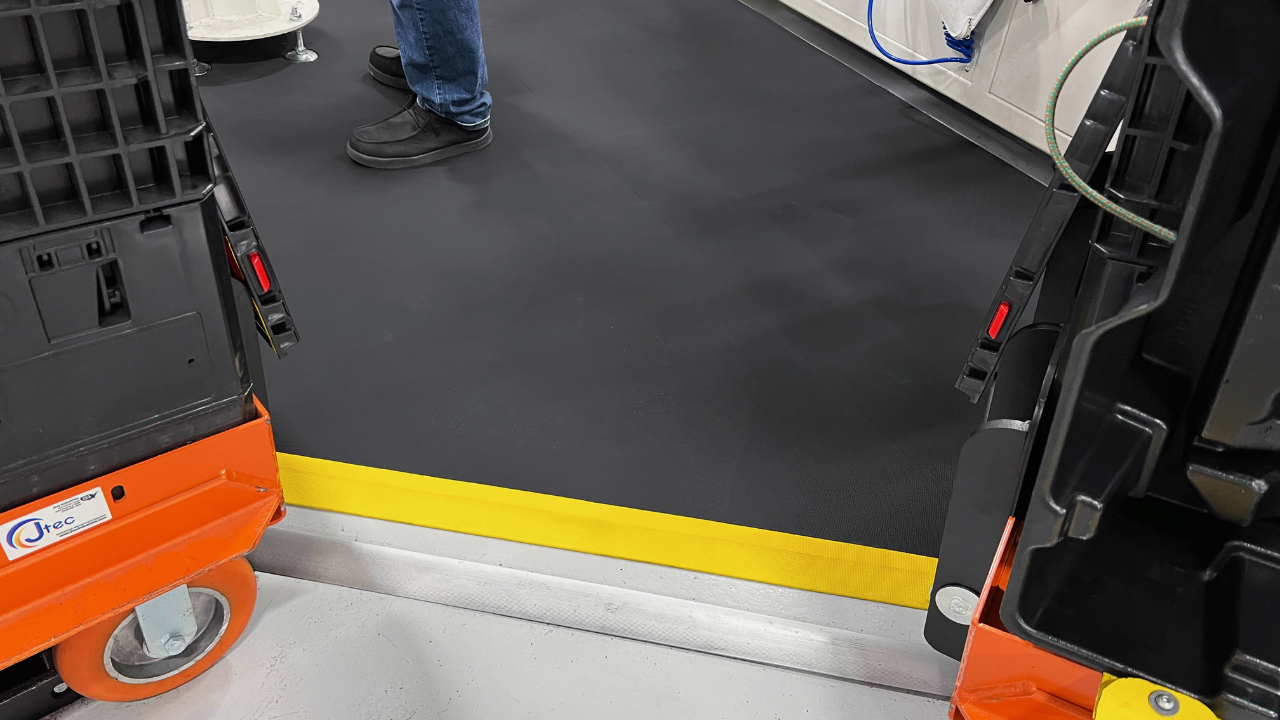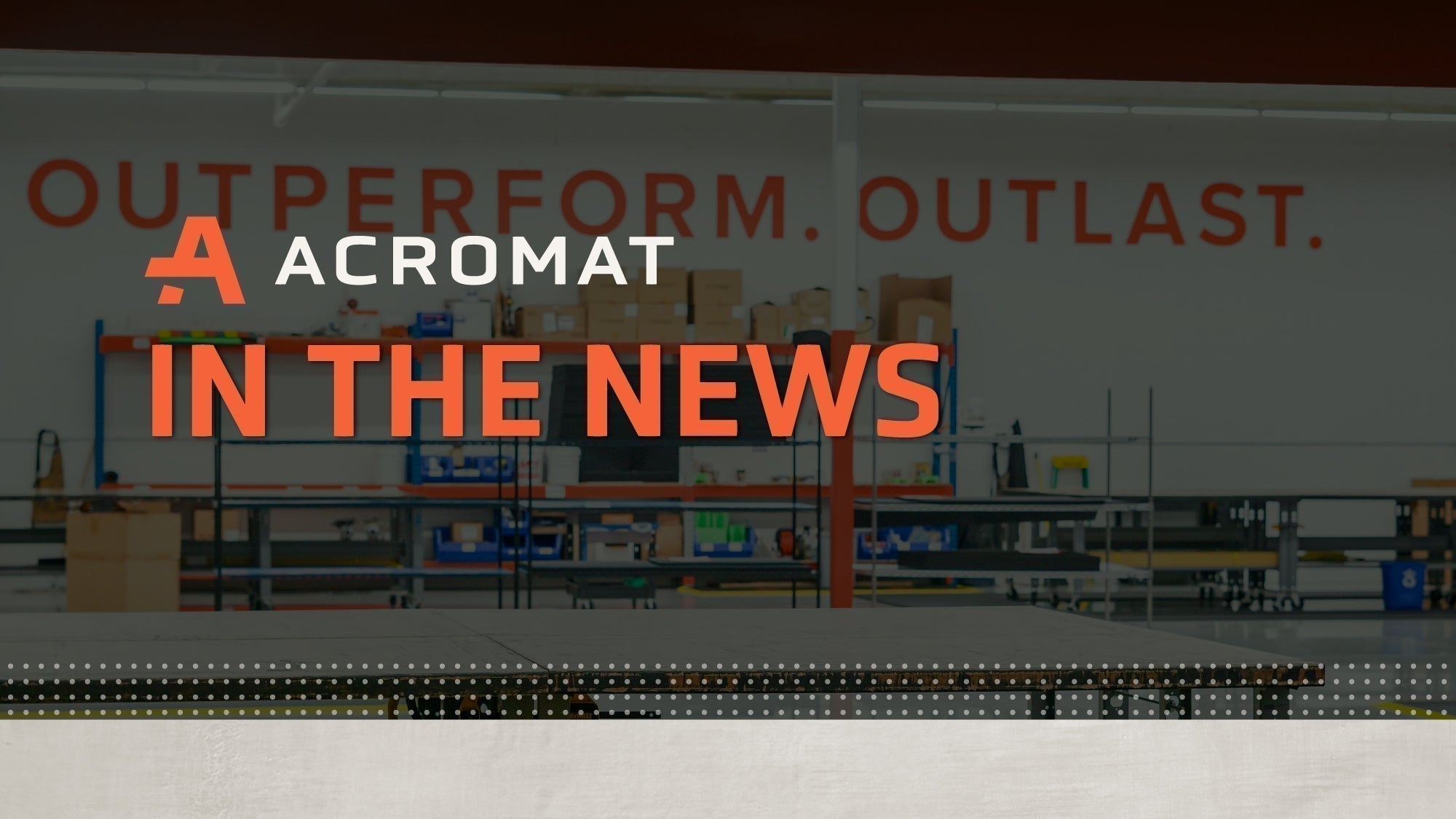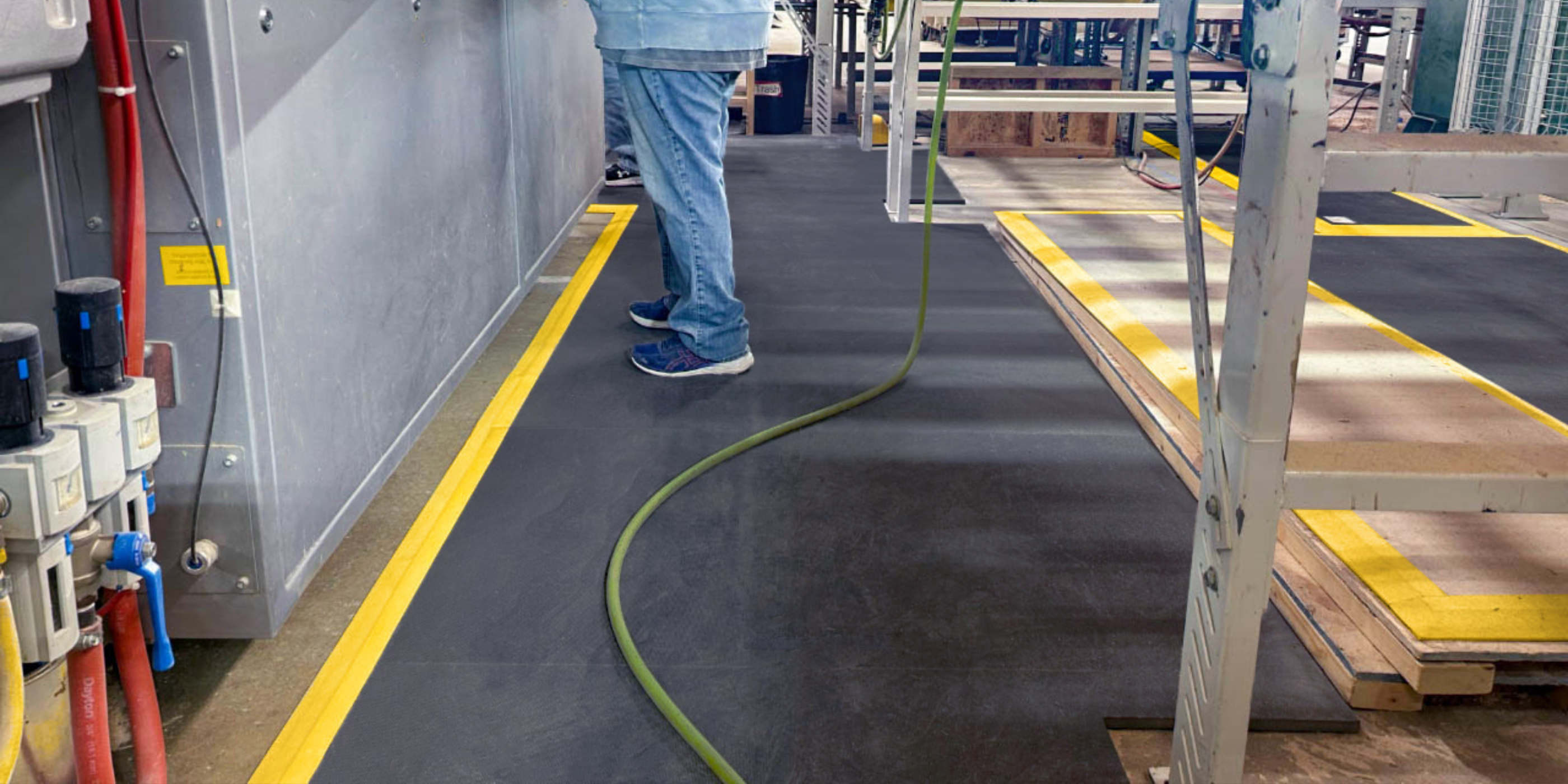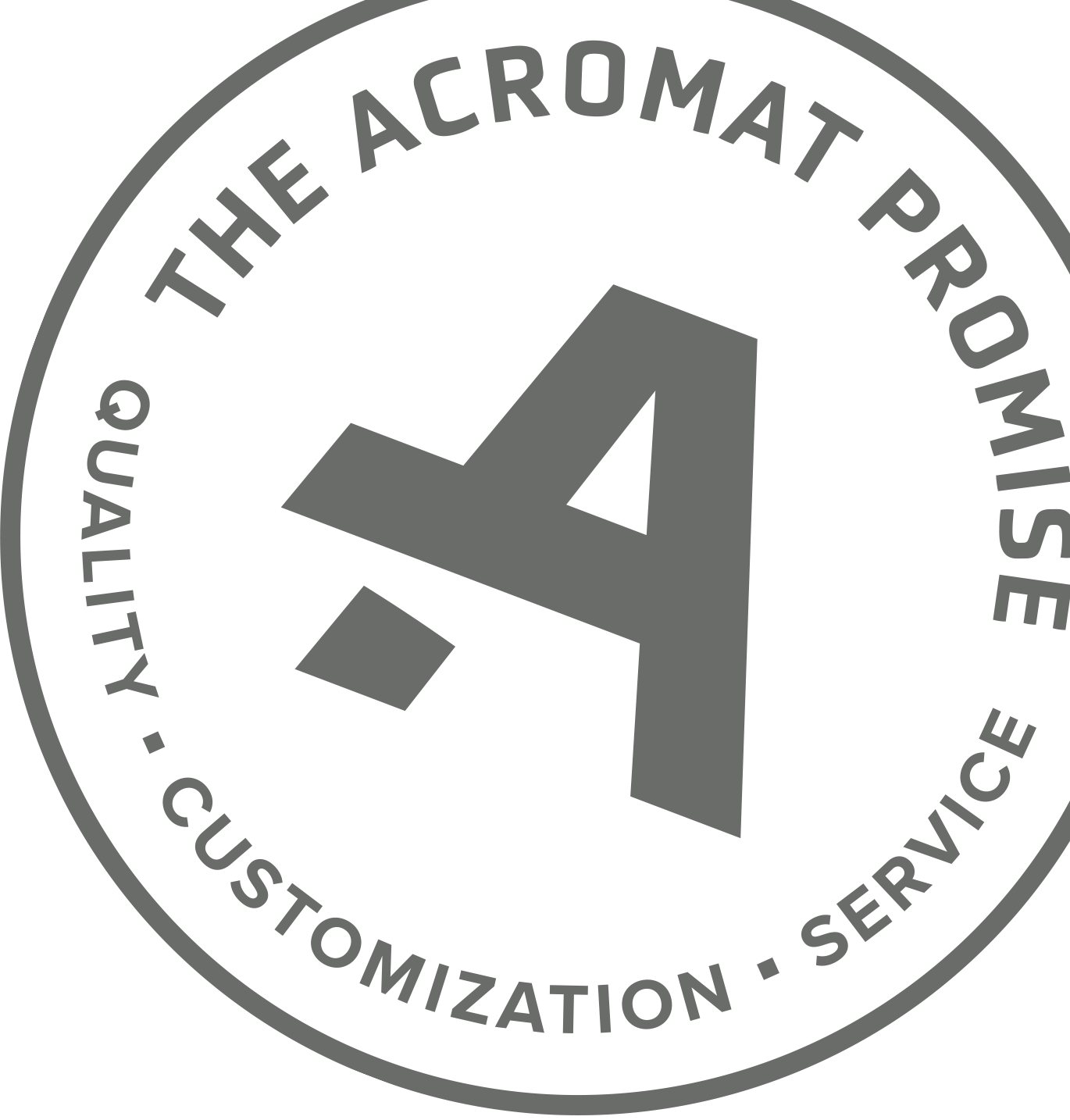Independent testing verifies AcroMat’s Lifetime Performance Warranty promise that our 100-Series anti-fatigue mats will never sink, flatten, or lose their ergonomic cushion.
Anti-fatigue mat performance goes beyond how they feel underfoot on day one – It’s about how your mats hold up during years of constant, heavy, real-world use.
This is why we put the nitrile material we use to make our 100-Series mats – specifically our 100-1 Series, 100-Cleanroom Series, and 100-ESD Series – through rigorous ASTM D3574-17 Dynamic Fatigue Test by Constant Force Pounding. Evaluated alongside two top-selling PVC foam mats, the results were clear: AcroMat anti-fatigue mats are 2.3-3.2X more resilient.
Below, we look at the ASTM D3574-17 force pounding process, key takeaways from the results, and how the data certifies AcroMat’s Lifetime Warranty promise that our 100-Series mats will remain permanently resilient and never bottom out.
1. Why Dynamic Fatigue Testing Matters
Anti-fatigue mats are subject to constant pounding. In manufacturing environments, workers are often on their mats for 8-12 hours a day. Over time, this repeated stress can cause ergo mats – primarily those made from extruded PVC foam – to break down and compress.
Anti-fatigue mats that lose their structure compromise safety and productivity. Sunken mats no longer provide the “anti-fatigue” benefit – contributing to MSD injuries, the No. 1 most reported workplace injury. Mats that bottom out can also cause the borders to curl, creating a dangerous trip hazard. These issues likewise cause productivity disruptions by forcing workers to hesitate when moving around, and tax your budget by requiring frequent re-purchases.

Left: AcroMat 100-Series molded nitrile material, guaranteed and warrantied to never sink, flatten, or lose its ergonomic cushion. Right: "Bottomed out" extruded PVC foam mat with a vinyl diamond-plate covering.
2. The Dynamic Fatigue Testing Process
ASTM International, with over 13,000 codes and standards, is trusted worldwide as the benchmark for evaluating the performance and safety of anti-fatigue mat products. In particular, ASTM D3574-17 Dynamic Fatigue Test by Constant Force Pounding is recognized as an industry-standard method for evaluating how well a mat's cushion will hold up to heavy use.
The D3574-17 Dynamic Fatigue Test helps determine whether your anti-fatigue mats will break down or maintain their structure by simulating years of use by compressing a mat 80,000 times over the course of 24 hours. Each compression includes a force of 170 lbs., the approximate weight of an average adult.
We had the AcroMat 100-1 Series, 100-Cleanroom Series, and 100-ESD Series mat material undergo the ASTM Dynamic Fatigue Test alongside two top-selling industrial mats. The AcroMat material is 5/8 in. thick, molded, closed cell, nitrile rubber foam. The other test mats are made from extruded PVC foam – the most commonly used material in the matting industry today – one with a standard surface and the other with a vinyl diamond-plate covering.

Pictured: AcroMat 100-Series molded, closed cell, nitrile rubber material preparing to undergo ASTM D3574-17 Dynamic Fatigue Test by Constant Force Pounding. Picture provided by DDL.

Pictured: Two traditional, extruded PVC foam mats, one with a standard foam surface and the other with a vinyl diamond-plate surface. Pictures provided by DDL.
DDL, an ISO/IEC 17025 accredited, and GMP, third-party testing lab based in Minnesota, conducted the ASTM D3574-17 Dynamic Fatigue testing of AcroMat's anti-fatigue mats and comparable PVC foam mats. DDL employs a team of scientists and engineers proficient in ASTM standards to help companies understand the performance of their products.
3. Results: AcroMat is 2-3X More Resilient
After 80,000 compressions, the AcroMat 100-Series maintained over 98% of its thickness and continued to regain shape and form – indicating uncompromised and permanent ergonomic cushion. Collectively, AcroMat proved to be 2.3X more resilient than the PVC foam mat with diamond-plate cover and 3.2X more resilient than the PVC foam mat with standard surface.

The AcroMat 100-Series nitrile material maintained over 98% of its original thickness after 80,000 compressions. Conversely, the PVC foam mats suffered 4.4% and 6.1% loss.
The key metric in this test is loss of thickness (%). Competitor Mat 1 lost 6.1% of its thickness after 80,000 compressions, while Competitor Mat 2 lost 4.4% of its thickness after 80,000 compressions. The AcroMat 100-Series nitrile material lost just 1.9% of its thickness.
A thickness retention greater than 98% indicates permanent resistance to deformation, while loss greater than 2% indicates higher likelihood of permanent deformation. Collectively, the AcroMat 100-Series proved to be 221% more resilient than Competitor Mat 1 and 131% more resilient than Competitor Mat 2 in terms of loss of thickness percentage.

Pictured: The AcroMat 100-1, 100-Cleanroom, and 100-ESD Series mats, made from molded nitrile rubber foam, in use within various customer manufacturing settings.
According to an engineer with DDL, "A low loss in thickness means the sample holds its shape." This insight is affirmed by Darcie Jaremy, Board Certified Professional Ergonomist and owner of ergonomicsHelp: "What sets [the AcroMat 100-Series] apart is that it is quite robust to stand on; it holds its shape very well ... After standing in one location for a while the mat doesn’t flatten and doesn’t require you to relocate your feet to get cushion and relief."
Further, the mats were measured at 60 minutes and 24 hours throughout the pounding process to assess whether they regained or continued to lose thickness over time. The AcroMat 100-Series nitrile material was the only mat to regain thickness from 60 minutes to 24 hours – indicating a return to its original shape despite constant pounding. Competitor Mat 1 measured 2.9X thinner at 24 hours than 60 minutes – indicating continued, permanent loss of thickness.

Screenshot from the final report showing how the AcroMat 100-Series nitrile material regained thickness over the course of 80,000 compressions, indicating a return to its original form despite constant pounding and verifying indefinite resilience.

Screenshot from the final report showing how Competitor Mat 1, traditional PVC foam, became 2.9X thinner over time as the force compression pounding wore on – indicating permanent breakdown from heavy use.
ASTM D3574-17 Test Results Summary:
-> The AcroMat 100-Series mat material, molded nitrile rubber foam, was tested alongside two traditional PVC foam mats; one a standard foam surface (Competitor Mat 1), the other with a vinyl diamond-plate surface (Competitor Mat 2).
-> The ASTM test involved 80,000 compressions (constant pounding) of 170 lbs. over 24 hours, measured after 60 minutes and 24 hours.
-> The 100-Series nitrile material maintained >98% of its thickness. A 98%+ thickness retention indicates permanent resistance to deformation and indefinite resilience.
-> The PVC foam mat with standard surface lost 6.1% of its thickness, while the PVC foam mat with diamond-plate surface lost 4.4%. Greater than 2% loss in thickness indicates likelihood of permanent deformation.
-> The PVC foam mat with standard surface lost 221% more thickness than the 100-Series nitrile material; the PVC foam mat with diamond-plate cover lost 131% more thickness.
-> The 100-Series nitrile material was the only mat to steadily regain thickness from 60 minutes to 24 hours (4.5% to 1.9%), indicating a permanent return to form despite constant pounding. Competitor Mat 1 steadily lost thickness over time (2.1% to 6.1%).

For comparison, various molded polyurethane automotive seating foams for Ford, Chrysler, and GM vehicles underwent the same ASTM D3574-17 testing process. Polyurethane is a material that is also often found in anti-fatigue mats. The seating foams lost between 2.5% and 3.8% thickness, all higher than the AcroMat nitrile material.
-> Based on percentage of thickness maintained/lost, the 100-Series nitrile material is 2.3X more resilient than the PVC foam mat with diamond-plate cover and 3.2X more resilient than the PVC foam mat with standard surface.
-> At AcroMat, we promise our molded, closed cell, nitrile 100-Series mats will remain permanently resilient and never sink, flatten, or lose their ergonomic cushion. We back this up with a Lifetime Performance Warranty. The results of the ASTM D3574-17 Dynamic Fatigue Test reaffirm our promise with internationally recognized, standardized data.

By combining AcroMat's custom-design capabilities with our permanently resilient nitrile material, this industrial manufacturer elevated safety and productivity while reducing year-over-year spend.
4. What These Results Mean for Safety and ROI
For companies in need of reliable anti-fatigue mats that will perform for years without issue or interruption, the takeaway from the ASTM D3574-17 Dynamic Fatigue testing is straightforward: Not all anti-fatigue mats are created equal.
Mats that lose their structure quickly don’t just wear out – they compromise safety, halt productivity, and tax your safety budget. Conversely, by choosing mats with proven compression resistance like AcroMat’s 100-Series, you can be certain your mats will:
- Maintain ergonomic performance indefinitely
- Lower total cost of ownership with fewer replacements
- Improve safety compliance with mats that retain their structure
- Support workforce morale and retention by improving daily comfort
Questions about the results above? Interested in a deeper dive into the testing process, data, and final report? Ready to experience the AcroMat difference with a free sample mat? Connect with our team today!
View additional testing results:
Mechanical Pull Test Verifies AcroMat 100-1 Series Seam Strength
AcroMat 100-1 Series Proves Zero Curl After Accelerated Aging




